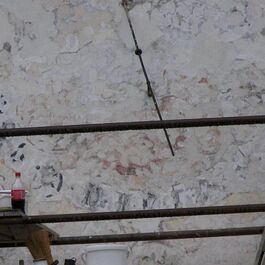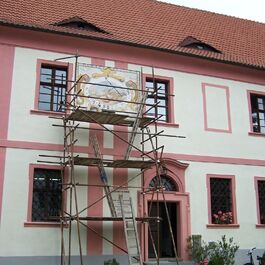Baroque Sundial on the Deanery
On October 12, 2010, the restoration of the Baroque sundial on the south facade of the deanery was completed. The Baroque sundial from the early 18th century was likely created around the same time as the clock on the building of the Latin School. Both the clock on the Latin School and likely the clock on the deanery were made by Siard Nosecký. S. Nosecký took his monastic vows in the Strahov Monastery in 1715 and was sent to Milevsko in 1716 to assist in teaching at the monastery school. After his return to the Strahov Monastery, he created a number of fresco paintings. He made six sundials on the building of the summer refectory. His most significant works include the painting of the Theological Hall of the Strahov Library.
- Restorer: Mgr. Josef Novotný
- Implementation: 2010
- ÚSKP registration number: 39572/032609
Financial contributors to the restoration:
- Royal Canonry of Premonstratensians at Strahov
Condition before restoration
The Baroque painting done on plaster was covered by a newer layer of plaster from the 20th century. This layer was only present on part of the original clock's painting. The original painting was visible on the uncovered part despite numerous patchings made at the time the painting was covered. After preliminary research, it was determined that it was possible to uncover the entire area of the original sundial.
Restoration process
A full uncovering of the modern plaster containing cement was carried out. At the same time, the original Baroque layer was reinforced by injection. Patches were filled, and a lime overpaint was removed. The framing with an egg-and-dart motif from the lime overpaint was retained. The painting was unified by retouching, and the missing left part of the clock was reconstructed. Finally, the surface of the painting was made hydrophobic.
From the very beginning, an expert in the dimensioning of sundials, Ing. Miloš Nosek, was involved in the restoration. Based on his measurements, it was necessary to add some parts of the lines and gnomon.
Summary and final condition after restoration
Despite the significant damage to the original Baroque painting of the sundial, it was possible to unify it with local retouching, thus restoring the clock to its original form.





